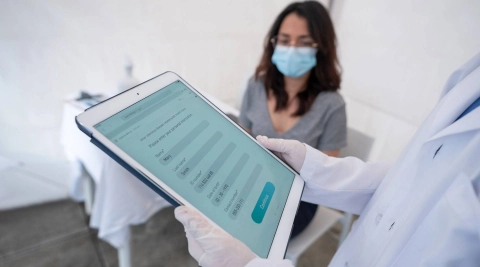Digital health The electronic medication treatment plan (eMP)
With the electronic medical treatment plan, all information about prescribed medication can be stored in one place on the electronic medical data card (eGK). This ensures that doctors, dentists, hospitals, therapists and pharmacists always have an overview of all medication a patient is taking.
At a glance
- People covered by statutory health insurance are entitled to a nationally standardized medication plan, containing information about prescribed medicines, their dosages and how to take them.
- If they want, they can store this as an electronic medication treatment plan (eMP) on their medical data card.
- The eMP also offers additional features – in addition to all currently prescribed drugs, patients can also store details of any medicines or food supplements they have purchased themselves.
- Details of medication taken in the past remain stored in the eMP.
- The eMP facilitates cooperation between doctors, dentists, therapists and pharmacists, and helps avoid interactions between different drugs.

What is a medication treatment plan?
It can be difficult for patients who take several drugs on a regular basis to keep track of these. The nationally standardized medication plan (BMP), introduced in 2016, provides support for those taking medication. It contains precise details of all drugs and their active ingredients and of how they are to be taken.
Doctors are required to create a medication plan for patients covered by statutory health insurance if:
- at least 3 drugs have been prescribed that have a systemic effect, i.e., an effect on the body as a whole and
- it is expected that these drugs will be taken for a period of at least 28 days
In particular, if various doctors prescribe medication for a patient, it is important for all to know what has already been prescribed and in which dosage. This is the only way to avoid potential interactions between drugs.
However, people don’t always carry the paper document with them and it can be misplaced. For this reason, patients can choose, if they so wish, to have details of their medication stored in an electronic medication treatment plan (eMP) on the electronic medical data card. In this way, all details of prescriptions can be reliably checked in a medical practice, by a therapist, in hospitals and in pharmacies. The usual medication plan can still also be printed out.
How does the electronic medication treatment plan differ from the nationally standardized medication plan?
The electronic medication treatment plan contains the following information, which is relevant for the patient’s treatment:
- personal profile data, such as name and date of birth
- the medication (both prescription and over-the-counter drugs, including their active substances)
- information on how the medication is to be used (dosage, type, frequency and times to be taken)
- information that is relevant for prescriptions, such as allergies, intolerances, body weight, kidney function or specification that the patient is currently pregnant
- comments area, in which doctors, therapists and pharmacists can enter notes about the medication and can exchange specialized information with one another
- details of medicines and food supplements purchased by the patient themselves
- Once details of medications are stored, they remain in the data record even after they are no longer prescribed for the patient. This enables future tracing of which medication was taken and when.
In this way, the electronic medication treatment plan contains more information than the nationally standardized medication plan in paper format – specifically, the last four items listed above.
What are the benefits of the electronic medication treatment plan?
The electronic medication treatment plan makes it safer for people to take medication. The plan ensures that doctors, dentists and pharmacists can see, at a glance, all medications that the patient is currently taking – allowing them to determine whether interactions or allergic reactions are likely to occur.
The electronic medication treatment plan is useful, for example, when:
- the patient purchases over-the-counter medication for themselves
- new drugs need to be prescribed
- a repeat prescription is required
- allergies or intolerances need to be considered in relation to drug treatment
- side effects occur
- the trade names of drugs change
How is the electronic medication treatment plan used?
The electronic medication treatment plan is an application of the electronic medical data card. Alongside emergency information, the card can also be used to store the patient’s personal medication plan. Use of the electronic medication treatment plan is voluntary.
The electronic medication treatment plan can be created in a medical practice, dental practice or pharmacy, provided that the patient consents to this being done. Your health card and a PIN that you receive from your health insurance company are required to create the plan.
The electronic medication treatment plan is then created in the management system used by the medical or dental practice or pharmacy and is transferred to the medical data card. You can receive a paper printout on request. A copy of the data remains in the management system.
It is useful to specify that you have an electronic medication treatment plan at each subsequent visit to the doctor/dentist/pharmacy so that your plan can be updated whenever your prescription changes.
Only people in certain professions are authorized to read your electronic medication treatment plan, i.e., doctors, psychotherapists, pharmacists and their employees. You need to give your consent each time before they do so.
Interesting fact: You consent to use of the electronic medication treatment plan by entering your medical data card PIN. This feature can be deactivated so that verbal consent is sufficient for future use.
Changing your electronic medical data card
If your health insurance provider sends you a new health card, your medication plan will not be stored on the new card, as the insurance provider doesn’t have access to the necessary data.
There are two ways to transfer your current electronic medication treatment plan to the new card:
- If you still have your old card, the data can be transferred onto the new card in a medical practice or pharmacy.
- If your old card has been lost, the data from the management system used by the practice or pharmacy will have to be transferred onto the new card – ideally in the location where the data was last updated to ensure that your new card has the latest information.
- Gematik GmbH. E-Medikationsplan. Aufgerufen am 13.05.2022.
- Kassenärztliche Bundesvereinigung (KBV). Medikationsplan. Aufgerufen am 13.05.2022.
As at:






